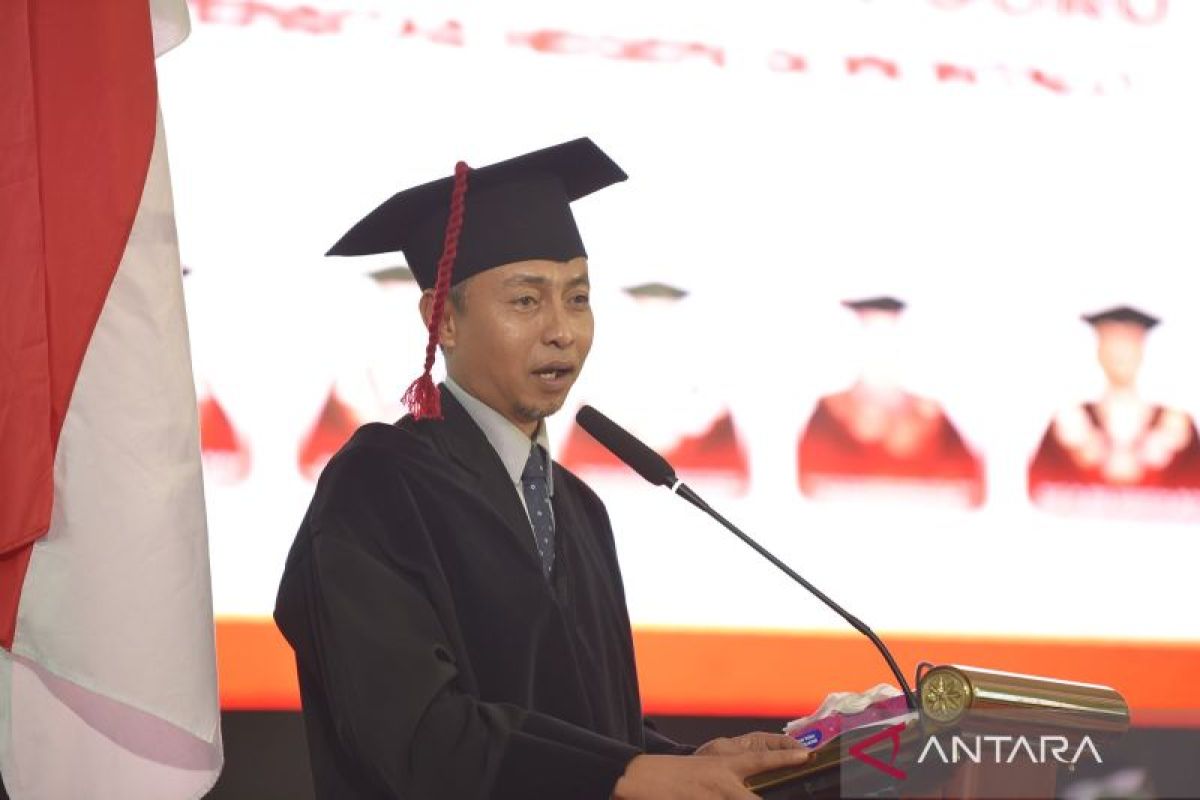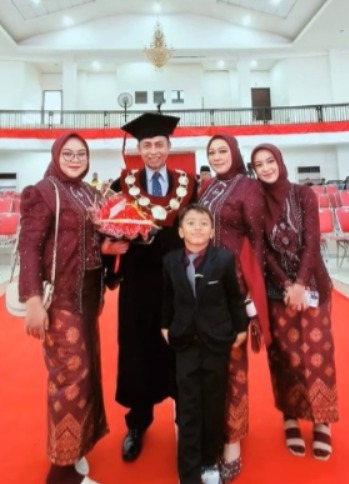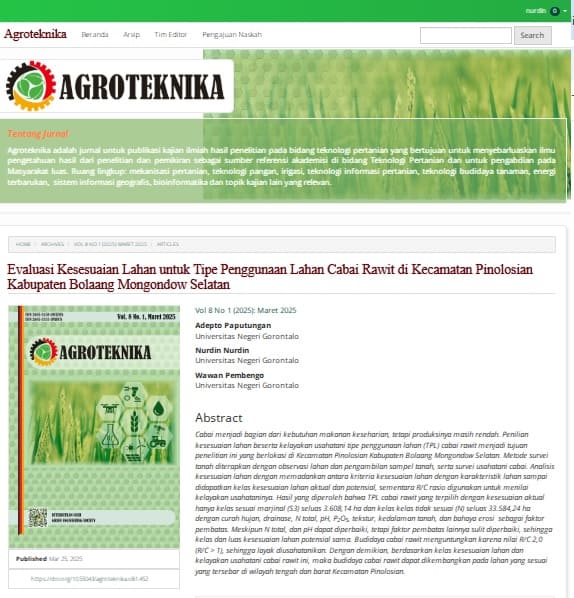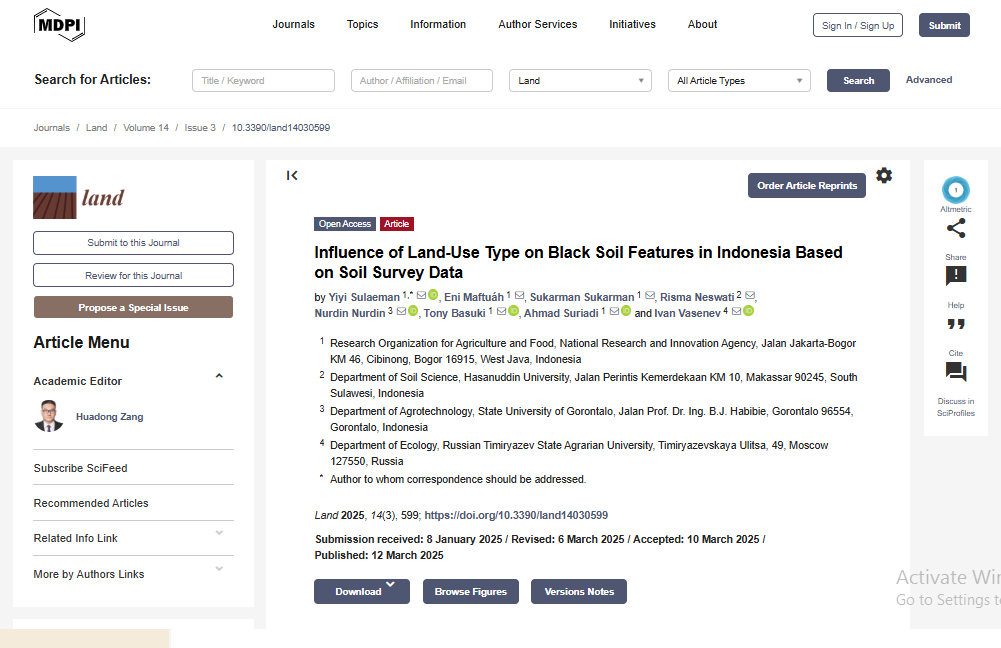Prosesi Pengukuhan Guru Besar Dalam Bidang Survei Tanah dan Evaluasi Lahan, Prof. Dr. Nurdin, SP, MSi


Guru Besar Survei Tanah dan Evaluasi Lahan Universitas Negeri Gorontalo (UNG), Prof. Dr. Nurdin, S.P., M.Si menegaskan pentingnya pendekatan baru dalam evaluasi kesesuaian lahan pertanian, khususnya untuk tanaman jagung. Penegasan ini disampaikan Prof. Nurdin dalam orasinya pada SIdang Terbuka Senat UNG Pengukuhan Guru Besar di Auditorium UNG, Selasa (24/6/2025). Orasi ilmiahnya yang berjudul “Rekacipta dan Inovasi Kriteria Kesesuaian Lahan untuk Tanaman Jagung Berbasis Kualitas Lahan dan Produksi Optimum”,
Mengawali orasi, Prof. Nurdin mengaitkan pentingnya tanah dalam sejarah peradaban, dari Mesopotamia hingga Nusantara, serta dalam perspektif agama. Ia mengutip Al-Qur’an Surah Al-A’raf ayat 58 yang menggambarkan bahwa hanya tanah yang baiklah yang mampu menumbuhkan tanaman dengan subur, sebagai bentuk tanda kebesaran Allah bagi orang-orang yang bersyukur. Seiring meningkatnya kebutuhan dan terbatasnya sumber daya lahan, Prof. Nurdin menyoroti ketidaksesuaian antara hasil evaluasi lahan konvensional yang berbasis kriteria FAO 1976 dengan realitas produksi di lapangan.
“Sering kali lahan yang dinilai kurang sesuai (kelas S3), justru mampu menghasilkan produksi hingga 8 ton per hektar,” ungkapnya.
Hal ini menunjukkan perlunya pendekatan baru yang lebih realistis dan akurat dalam penentuan kesesuaian lahan. Ia menelaah beberapa kriteria kesesuaian lahan jagung yang selama ini digunakan oleh para ahli seperti Zainuddin, Ritung, dan Wahyunto, yang memuat antara 11–12 kualitas lahan dan 21–24 karakteristik. Namun menurutnya, banyaknya variabel ini justru menyulitkan dalam penyusunan perencanaan tata ruang wilayah, RPJM, dan dokumen kebijakan lainnya, serta mengurangi akurasi data.
Sebagai solusi, Ia memperkenalkan inovasi kriteria kesesuaian lahan baru yang berbasis pada varietas jagung (lokal, komposit, dan hibrida), serta menggunakan pendekatan ilmiah dengan metode SEM-PLS dan Boundary Line. Hasilnya, ditemukan bahwa jumlah kualitas dan karakteristik lahan yang relevan jauh lebih sedikit, namun lebih tepat sasaran.
Untuk varietas lokal, hanya lima kriteria utama yang dinilai penting: ketersediaan oksigen, media perakaran, retensi hara, hara tersedia, serta bahaya erosi dan penyiapan lahan. Varietas komposit hanya memerlukan tiga: media perakaran, retensi hara, dan hara tersedia. Sementara varietas hibrida kembali menekankan lima elemen, meskipun dengan fokus yang lebih adaptif terhadap kondisi lahan spesifik.
“Inovasi ini menjadikan kriteria kesesuaian lahan lebih responsif terhadap variasi kualitas dan karakteristik lahan di lapangan, serta disusun berdasarkan produksi optimum masing-masing varietas jagung,” ujarnya.
Sebagai penutup, Prof. Nurdin menekankan bahwa meskipun kriteria baru ini lebih efisien dan adaptif, ia masih terbatas pada wilayah dataran rendah beriklim tropis. Oleh karena itu, diperlukan perluasan kajian ke wilayah dataran tinggi agar kriteria ini dapat digunakan lebih luas secara nasional. (Rama/Gopos)
Evaluasi Kesesuaian Lahan untuk Tipe Penggunaan Lahan Cabai Rawit di Kecamatan Pinolosian Kabupaten Bolaang Mongondow Selatan

Vol 8 No 1 (2025): Maret 2025
Adepto Paputungan
Universitas Negeri Gorontalo
Nurdin
Universitas Negeri Gorontalo
Wawan Pembengo
Universitas Negeri Gorontalo
Abstract
Cabai menjadi bagian dari kebutuhan makanan keseharian, tetapi produksinya masih rendah. Penilian kesesuaian lahan beserta kelayakan usahatani tipe penggunaan lahan (TPL) cabai rawit menjadi tujuan penelitian ini yang berlokasi di Kecamatan Pinolosian Kabupaten Bolaang Mongondow Selatan. Metode survei tanah diterapkan dengan observasi lahan dan pengambilan sampel tanah, serta survei usahatani cabai. Analisis kesesuaian lahan dengan memadankan antara kriteria kesesuaian lahan dengan karakteristik lahan sampai didapatkan kelas kesesuaian lahan aktual dan potensial, sementara R/C rasio digunakan untuk menilai kelayakan usahataninya. Hasil yang diperoleh bahwa TPL cabai rawit yang terpilih dengan kesesuaian aktual hanya kelas sesuai marjinal (S3) seluas 3.608,14 ha dan kelas kelas tidak sesuai (N) seluas 33.584,24 ha dengan curah hujan, drainase, N total, pH, P2O5, tekstur, kedalaman tanah, dan bahaya erosi sebagai faktor pembatas. Meskipun N total, dan pH dapat diperbaiki, tetapi faktor pembatas lainnya sulit diperbaiki, sehingga kelas dan luas kesesuaian lahan potensial sama. Budidaya cabai rawit menguntungkan karena nilai R/C 2,0 (R/C > 1), sehingga layak diusahatanikan. Dengan demikian, berdasarkan kelas kesesuaian lahan dan kelayakan usahatani cabai rawit ini, maka budidaya cabai rawit dapat dikembangkan pada lahan yang sesuai yang tersebar di wilayah tengah dan barat Kecamatan Pinolosian.
Influence of Land-Use Type on Black Soil Features in Indonesia Based on Soil Survey Data

by Yiyi Sulaeman1, Eni Maftuáh1,Sukarman Sukarman1, Risma Neswati2, Nurdin Nurdin3, Tony Basuki1, Ahmad Suriadi1 and Ivan Vasenev4
1Research Organization for Agriculture and Food, National Research and Innovation Agency, Jalan Jakarta-Bogor KM 46, Cibinong, Bogor 16915, West Java, Indonesia2Department of Soil Science, Hasanuddin University, Jalan Perintis Kemerdekaan KM 10, Makassar 90245, South Sulawesi, Indonesia3Department of Agrotechnology, State University of Gorontalo, Jalan Prof. Dr. Ing. B.J. Habibie, Gorontalo 96554, Gorontalo, Indonesia4Department of Ecology, Russian Timiryazev State Agrarian University, Timiryazevskaya Ulitsa, 49, Moscow 127550, Russia*Author to whom correspondence should be addressed.Land 2025, 14(3), 599; https://doi.org/10.3390/land14030599
Abstract
Black soils refer to soils with black, thick upper layers containing 0.6% or more soil organic carbon in the tropical region. This high organic carbon content makes these soils essential for climate change control and food production. In Indonesia, black soils are found under forests, shrublands, and grasslands in tropical monsoon and savannah climates. Land clearing for agricultural uses will change black soil properties; however, knowledge of change (level, direction, and sensitivity) is limited. Meanwhile, soil surveying records land-use types and collects soil samples, resulting in voluminous legacy soil data. This study aimed to compare the mean difference in soil properties between two land-cover/use types. We used 142 black soil datasets containing legacy data on particle size distribution (sand, silt, clay), pH, soil organic carbon (SOC), total nitrogen (TN), available P2O5 (AP), and exchangeable cations (Ca, Mg, K, Na). We calculated the Hedges’s g-index for effect size assessment and performed a Welch’s t-test for significant differences. The results show that, compared to the forest, the agricultural dryland and monoculture home gardens have a large effect size and trigger changes in many soil properties. In contrast, mixed home gardens and paddy fields have a small effect size. In decreasing order, the black soil properties sensitive to change are TN > SOC = exchangeable K > exchangeable Mg = available phosphorus = pH = exchangeable Na > sand = silt = clay > exchangeable Ca. The results suggest that a combination of home gardens and paddy fields better supports food security and mitigates climate change in black soils. In addition, the legacy soil data can be used to monitor soil property changes.
Keywords: black soil; climate change; effect size; land use; soil properties
Evaluasi Lahan Untuk Tanaman Padi Sawah Secara Parametrik Di Dusun Moliliulo Desa Tangga Barito, Kecamatan Dulupi, Kabupaten Boalemo

Jurnal Ilmiah Mahasiswa Fakultas Pertanian (JIMFP), Volume 4 Nomor 2 (2024): 435–443
Moh. Reynaldi Pakaya, Nurdin, Iswan Dunggio, Rival Rahman
Universitas Negeri Gorontalo
Abstract
The process of evaluating land's suitability for a particular use, such as finding prospective new land for rice field is known as land evaluation. The purpose of this study was to determine the characteristics, the quality, and the suitability of land parametrically for the development of rice field. This research took place in Moliliulo, Tangga Barito Village, Dulupi District, Boalemo Regency, from March to August 2022. This research used a detailed level survey method where the variables observed were land characteristics in the form of physical properties, and then the chemical properties were analyzed in the laboratory. Furthermore, an analysis of the characteristics and suitability of land for rice field was carried out using a parametric approach. The results of this study indicated that the characteristics and quality of the land in the study area varied greatly from low to high category, starting from climate, land, and soil nutrient availability factors. The research location has 4 land suitability classes for rice field (Oryza sativa L.), namely class 1 (excellent) with an area of 17.52 ha (2.15%), class 2 (good) with an area of 3.08 ha (0. 38%), class 3 (sufficient) with an area of 710.44 ha (87.15%), and class 4 (poor) with an area of 58.15 ha (7.13%).
Pertumbuhan dan hasil jagung komposit varietas lamuru pada beberapa kelas lereng dan dosis pemupukan di desa Payu Kabupaten Gorontalo

Agriland : Jurnal Ilmu Pertanian Vol 12, No 1 (2024)
Ilyas Djuna, Nurdin Nurdin, Wawan Pembengo, Rival Rahman
Universitas Negeri Gorontalo
Abstract
Penelitian ini bertujuan untuk mengetahui pertumbuhan dan hasil tanaman jagung komposit pada beberapa kelas lereng dan dosis pemupukan di Desa Payu Kabupaten Gorontalo. Waktu pelaksanaan mulai Oktober 2019 sampai Mei 2020. Metode Penelitian menggunakan Rancangan petak terpisah dengan petak utama adalah empat kelas lereng dan anak petak adalah dosis pemupukan dengan 3 perlakuan. Paremeter yang diamati adalah sampel tanah, tinggi tanaman, jumlah daun, umur berbunga jantan dan betina, panjang tongkol, jumlah biji dan berat biji. Analisis data diuji dengan Duncan Multiple Range Test (DMRT) pada taraf signifikan 5%. Hasil penelitian menunjukkan bahwa kelas lereng bergelombang (8-15%) dan pupuk NPK 50 kg/ha mempengaruhi pertumbuhan dan hasil jagung. Terdapat interaksi antara kelas lereng bergelombang (0-8%) dan tanpa pupuk terhadap pertumbuhan dan hasil tanaman jagung komposit.
Kategori
- Abstract 2006
- Abstract 2009
- Abstract 2011
- Abstract 2012
- Abstract 2013
- Abstract 2014
- Abstract 2016
- Abstract 2018
- Abstract 2019
- Abstract 2020
- Abstract 2021
- Abstract 2022
- Abstract 2023
- Abstract 2024
- Abstract 2025
- Buku
- Kiprah Tugas Pembantuan ASN-Dosen
- Kunjungan Luar Negeri
- Mata Kuliah
- Pengukuhan Guru Besar, Prof. Dr. Nurdin, SP, MSi
- Project 2009
- Project 2010
- Project 2013
- Project 2018
- Project 2019
- Project 2020
- Project 2021
- Project 2022
- Publikasi Ilmiahku
- Soil Scientist from Gorontalo
Arsip
Blogroll
- a-SintaID
- b-Google Scholar
- c-Scopus ID
- d-Web of Science (WoS) ID
- e-ResearchGate
- f-Academia.edu
- g-SciProfiles
- h-Loop ID
- i-LinkedIn
- j-OrcidID
- k-figshare
- l-Youtube
- m-Twitter
- n-Facebook
- o-Universitas Negeri Gorontalo
- p-BIMA-Kemendikbud RI
- q-FAPERTA UNG
- r-LP2M UNG
- s- LP3M UNG
- t-SIMPPM UNG
- u-SIMLIT UNG
- v-Rispro LPDP
- w-BRIIN
- x-PDDIKTI
- y-GRS BPDPKS
- z-kampusmerdeka
- z1-ANJANI
- z10-SIAT UNG
- z11-Aplikasi SIAGA
- z12-SPADA Indonesia
- z13-SISTER
- z14-tesaurus.kemdikbud
- z15-UKBI
- z16-typoonline
- z17-Turnitin
- z18-Zetero
- z2-eHAKI
- z20-Himpunan Ilmu Tanah Indonesia(HITI)
- z21-BKN
- z21-Kementan RI
- z22-BPS Provinsi Gorontalo
- z23-BPS Kabupaten Boalemo
- z24-BPS Kabupaten Bone Bolango
- z25-BPS Kabupaten Gorontalo
- z26-BPS Kabupaten Gorontalo Utara
- z27-BPS Kabupaten Pohuwato
- z3-Arjuna
- z4-DIKTI
- z5-GARUDA Dikti
- z6-SIM Karier dan SDM Kemendikbud
- z7-KBBI
- z8-Kedaireka
- z9-RAMA
